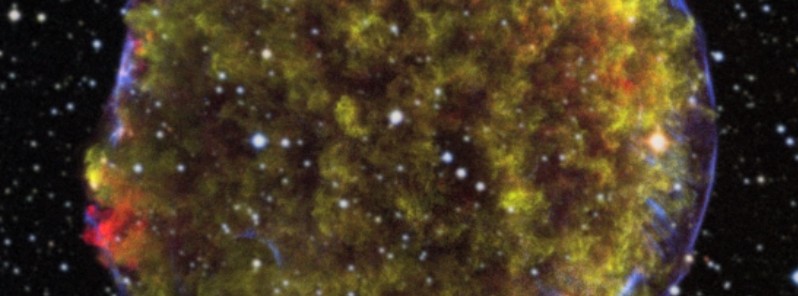X-ray observatory captures expanding debris from a stellar explosion

Using data from NASA's Chandra X-ray Observatory, the NSF’s Karl G. Jansky Very Large Array (VLA) and many other telescopes astronomers are observing the debris field from supernova explosion first extensively observed and written about by Danish astronomer Tycho Brahe in 1572.
Today, we know that the Tycho's supernova remnant was created by the explosion of a dwarf star, making it part of the so-called Type Ia class of supernovas used to track the expansion of the Universe. Since much of the material being flung out from the shattered star has been heated by shock waves − similar to sonic booms from supersonic planes − passing through it, the remnant glows strongly in X-ray light.
Astronomers have now used Chandra observations from 2000 through 2015 to create the longest movie of the Tycho remnant’s X-ray evolution over time, using five different images. This shows the expansion from the explosion is still continuing about 450 years later, as seen from Earth’s vantage point roughly 10 000 light years away.
Credit: NASA/CXC/GSFC/B.Williams et al
By combining the X-ray data with some 30 years of observations in radio waves with the VLA, astronomers have also produced a movie, using three different images. They have used these X-ray and radio data to learn new things about this supernova and its remnant.
Credit: NSF/NRAO/VLA
The researchers measured the speed of the blast wave at many different locations around the remnant. The large size of the remnant enables this motion to be measured with relatively high precision.
Although the remnant is approximately circular, there are clear differences in the speed of the blast wave in different regions. The speed in the right and lower right directions is about twice as large as that in the left and the upper left directions. This difference was also seen in earlier observations.
This range in speed of the blast wave’s outward motion is caused by differences in the density of gas surrounding the supernova remnant.
This causes an offset in position of the explosion site from the geometric center, determined by locating the center of the circular remnant. The astronomers found that the size of the offset is about 10% of the remnant’s current radius, towards the upper left of the geometric center. The team also found that the maximum speed of the blast wave is about 12 million miles per hour.
Offsets such as this between the explosion center and the geometric center could exist in other supernova remnants. Understanding the location of the explosion center for Type Ia supernovas is important because it narrows the search region for a surviving companion star. Any surviving companion star would help identify the trigger mechanism for the supernova, showing that the white dwarf pulled material from the companion star until it reached a critical mass and exploded.
The lack of a companion star would favor the other main trigger mechanism, where two white dwarfs merge causing the critical mass to be exceeded, leaving no star behind.

The significant offset from the center of the explosion to the remnant’s geometric center is a relatively recent phenomenon. For the first few hundred years of the remnant, the explosion’s shock was so powerful that the density of gas it was running into did not affect its motion. The density discrepancy from the left side to the right has increased as the shock moved outwards, causing the offset in position between the explosion center and the geometric center to grow with time. So, if future X-ray astronomers, say 1 000 years from now, do the same observation, they should find a much larger offset.
Source: Chandra X-ray Observatory
References:
- "An X-ray and Radio Study of the Varying Expansion Velocities in Tycho's Supernova Remnant" – Brian J. Williams, Laura Chomiuk, John W. Hewitt, John M. Blondin, Kazimierz J. Borkowski, Parviz Ghavamian, Robert Petre, Stephen P. Reynolds – Pape accepted for publication in The Astrophysical Journal Letters. Available online.
- Tycho's Supernova Remnant: Chandra Movie Captures Expanding Debris From a Stellar Explosion – NASA/Chandra
Featured image credit: NASA/CXC/GSFC/B.Williams et al;

Commenting rules and guidelines
We value the thoughts and opinions of our readers and welcome healthy discussions on our website. In order to maintain a respectful and positive community, we ask that all commenters follow these rules:
We reserve the right to remove any comments that violate these rules. By commenting on our website, you agree to abide by these guidelines. Thank you for helping to create a positive and welcoming environment for all.